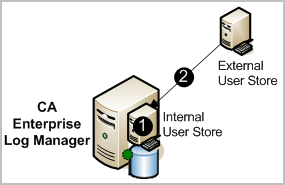

When you configure the user store, you choose whether to use the default user store on the CA User Activity Reporting Module for setting up user accounts or reference an external user store where user accounts are already defined. The underlying database is exclusive to CA User Activity Reporting Module and does not use a commercial DBMS.
Supported external user stores include CA SiteMinder and LDAP directories such as Microsoft Active Directory, Sun One, and Novell eDirectory. If you reference an external user store, user account information is automatically loaded in read-only format as shown by the arrow in the following diagram. You define only application-specific details to selected accounts. No data is moved from the internal user store to the referenced external user store.

The numbers on the illustration refer to these steps:
Note: See the CA User Activity Reporting Module Implementation Guide for details on configuring basic user access. See the CA User Activity Reporting Module Administration Guide for details on policies supporting predefined roles, creating user accounts, and assigning roles.
|
Copyright © 2013 CA.
All rights reserved.
|
|